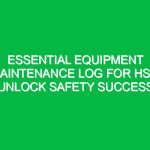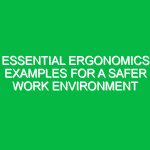Welcome to Our Toolbox Talk
Hello team, and thank you for gathering today for this important Toolbox Talk. Our focus will be on the concept of Trips within the Health, Safety, and Environment (HSE) domain. Understanding and managing Trips is crucial for ensuring a safe working environment and minimizing accidents. Let’s dive deep into why recognizing and preventing Trips is essential in our daily operations.
Understanding Trips in the HSE Context
In the realm of HSE, the term Trips refers primarily to trips and falls—one of the most common causes of workplace injuries. These incidents can occur due to various factors such as uneven surfaces, cluttered walkways, inadequate lighting, and more. Addressing these Hazards is not just about compliance; it’s about creating a culture of Safety where everyone looks out for one another.
Why Focus on Trips?
According to statistics, slips, trips, and falls account for a significant percentage of workplace injuries across various industries. The implications of these incidents can range from minor injuries to severe consequences that can affect not only the injured employee but also their coworkers and the overall productivity of the team. By understanding the causes and preventative measures related to Trips, we can significantly reduce these risks.
Common Causes of Trips
Let’s take a closer look at some common causes of Trips that we might encounter:
- Uneven Surfaces: Cracks in the pavement or uneven flooring can easily lead to trips.
- Obstructions: Tools, equipment, and materials left in walkways can create hazardous conditions.
- Poor Lighting: Inadequate lighting can make it difficult to see potential trip Hazards.
- Improper Footwear: Wearing inappropriate shoes can increase the likelihood of trips and falls.
The Importance of Preventing Trips
Preventing Trips is not just about avoiding accidents; it’s also about enhancing productivity and morale in the workplace. When employees feel safe, they are more focused and engaged in their work. Additionally, reducing incidents of Trips can lower insurance costs and improve our overall Safety record.
Real-Life Example
Consider a scenario where a colleague trips over a hose that was left lying across a walkway. This incident not only results in injury but also disrupts the workflow for others as they may need to assist or deal with the aftermath. By simply ensuring that all hoses and cables are properly stored away, we can prevent such accidents and keep our work environment safe and productive.
Best Practices for Preventing Trips
Now that we understand the importance of addressing Trips, let’s discuss some practical steps we can all take to prevent these incidents:
- Maintain Cleanliness: Always keep work areas tidy and free of obstructions. Regularly check walkways to ensure they are clear.
- Use Proper Signage: If an area is under repair, use clear signage to alert others to potential hazards.
- Wear Appropriate Footwear: Ensure you are wearing shoes that provide adequate support and traction.
- Conduct Regular Inspections: Perform routine checks of your work area for potential trip hazards.
Encourage a Culture of Safety
Everyone has a role to play in maintaining a safe environment. If you notice a potential hazard, report it immediately. Encourage your teammates to do the same. Remember, safety is a shared responsibility.
Identifying Potential Hazards
It’s crucial to be proactive in identifying potential hazards associated with Trips. Here are some tips to help you spot and assess risks:
- Visual Inspections: Regularly scan your environment for hazards during your daily routine.
- Employee Feedback: Encourage open communication among team members regarding safety concerns.
- Training Sessions: Participate in Training that focuses on hazard recognition and Prevention.
Regulations and Standards
Adhering to safety Regulations and standards is paramount to ensuring our workplace remains safe. Familiarize yourself with the Occupational Safety and Health Administration (OSHA) guidelines and our company’s safety policies regarding Trips. Compliance with these regulations not only protects you but also safeguards our organization from legal implications and fines.
Conclusion
To wrap up today’s Toolbox Talk, I want to highlight the key points we discussed. Understanding the concept of Trips, recognizing potential hazards, and implementing Best Practices are essential steps in maintaining a safe working environment. By being vigilant and proactive, we can significantly reduce the number of incidents related to Trips.
Thank you for your attention and commitment to safety. Let’s take what we’ve learned today and put it into practice. Remember, safety is everyone’s responsibility, and together we can create a safer workplace for all. Do you have any questions or comments about what we’ve discussed today?


